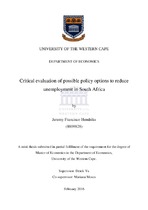| dc.description.abstract | Since the advent of democracy, one of the most serious economic problems facing the South African economy is the persistently high unemployment. Although employment has been increasing in general since the economic transition, the extent of such increase is not rapid enough to absorb the expanding labour force entrants, thereby causing both the level and rate of unemployment to increase. This is indicated by the fact that, despite the increase of employment number from 9.5 million in 1995 to 15.2 million in 2014, the number of unemployed increased from 2.0 million to 5.2 million during the same period, thereby causing the unemployment rate to rise from 17.6% to 25.4%. In fact, the labour market objective of the Accelerated and Shared Growth Initiative of South Africa (ASGISA) to reduce the unemployment rate to 15% by the end of 2014 is not achieved. The government has been trying to solve the unemployment problem by means of various policies, ranging from the “big” policies like the Reconstruction and Development Program (RDP), Growth, Employment and Redistribution Policy (GEAR), the aforementioned ASGISA, and the recently launched National Development Plan (NDP), to the more specific labour market policies such as the Expanded Public Works Program (EPWP), promotion of small, medium and micro enterprises (SMMEs) to the implementation of the Employment Tax Incentives Bill (also known as the Youth Wage Subsidy) since 1 January 2014. This study first provides a theoretical framework on various models of unemployment, before the main causes of unemployment in South Africa are discussed. A critical evaluation of the pros and cons of various policy options to alleviate unemployment would be looked at. Some of the policy options have already been implemented in South Africa for years and hence the possible success of these policies would be investigated in detail. Few policies have only been recently implemented (e.g. the Employment Tax Incentives Bill), while other possible policy options have not yet been implemented in South Africa (e.g. job-seeking transport subsidy) but have been adopted in other countries. Hence, the feasibility of these options for South
Africa would be investigated, by examining the outcome of these policies in the other countries. | en_US |

